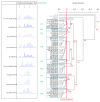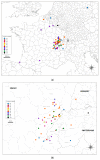Genotyping Echinococcus multilocularis in Human Alveolar Echinococcosis Patients: An EmsB Microsatellite Analysis
- PMID: 32295095
- PMCID: PMC7238142
- DOI: 10.3390/pathogens9040282
Genotyping Echinococcus multilocularis in Human Alveolar Echinococcosis Patients: An EmsB Microsatellite Analysis
Abstract
For clinical epidemiology specialists, connecting the genetic diversity of Echinococcus multilocularis to sources of infection or particular sites has become somewhat of a holy grail. It is very difficult to trace the infection history of alveolar echinococcosis (AE) patients as there may be an incubation period of five to 15 years before reliable diagnosis. Moreover, the variability of parasitic manifestations in human patients raises the possibility of genetically different isolates of E. multilocularis having different levels of pathogenicity. Thus, the exposure of human patients to different strains or genotypes circulating in geographically different environments may lead to different disease outcomes. Molecular tools, such as the microsatellite marker EmsB, were required to investigate these aspects. This genetic marker was previously tested on a collection of 1211 European field samples predominantly of animal origin, referenced on a publicly available database. In this study, we investigated a panel of 66 metacestode samples (between 1981 and 2019) recovered surgically from 63 patients diagnosed with alveolar echinococcosis originating from four European countries (France, Switzerland, Germany, Belgium). In this study, we identified nine EmsB profiles, five of which were found in patients located in the same areas of France and Switzerland. One profile was detected on both sides of the French-Swiss border, whereas most patients from non-endemic regions clustered together in another profile. EmsB profiles appeared to remain stable over time because similar profiles were detected in patients who underwent surgery recently and patients who underwent surgery some time ago. This study sheds light on possible pathways of contamination in humans, including proximity contamination in some cases, and the dominant contamination profiles in Europe, particularly for extrahepatic lesions.
Keywords: Alveolar echinococcosis; Echinococcus multilocularis; European endemic area; contamination event; genotyping; microsatellite EmsB.
Conflict of interest statement
The authors have no conflict of interest to declare.
Figures






Similar articles
-
Red foxes harbor two genetically distinct, spatially separated Echinococcus multilocularis clusters in Brandenburg, Germany.Parasit Vectors. 2021 Oct 14;14(1):535. doi: 10.1186/s13071-021-05038-0. Parasit Vectors. 2021. PMID: 34649615 Free PMC article.
-
Genetic diversity of Echinococcus multilocularis specimens isolated from Belgian patients with alveolar echinococcosis using EmsB microsatellites analysis.Infect Genet Evol. 2023 Dec;116:105531. doi: 10.1016/j.meegid.2023.105531. Epub 2023 Nov 20. Infect Genet Evol. 2023. PMID: 37992792
-
Echinococcus multilocularis genetic diversity in Swiss domestic pigs assessed by EmsB microsatellite analyzes.Vet Parasitol. 2021 May;293:109429. doi: 10.1016/j.vetpar.2021.109429. Epub 2021 Apr 17. Vet Parasitol. 2021. PMID: 33895467
-
Epidemiology of alveolar echinococcosis with particular reference to China and Europe.Parasitology. 2003;127 Suppl:S87-107. Parasitology. 2003. PMID: 15027607 Review.
-
The genomic Echinococcus microsatellite EmsB sequences: from a molecular marker to the epidemiological tool.Parasitology. 2010 Mar;137(3):439-49. doi: 10.1017/S0031182009991612. Epub 2009 Dec 22. Parasitology. 2010. PMID: 20025824 Review.
Cited by
-
Red foxes harbor two genetically distinct, spatially separated Echinococcus multilocularis clusters in Brandenburg, Germany.Parasit Vectors. 2021 Oct 14;14(1):535. doi: 10.1186/s13071-021-05038-0. Parasit Vectors. 2021. PMID: 34649615 Free PMC article.
-
Extrahepatic alveolar echinococcus on multi-slice computed tomography and magnetic resonance imaging.Sci Rep. 2021 Apr 30;11(1):9409. doi: 10.1038/s41598-021-89101-x. Sci Rep. 2021. PMID: 33931712 Free PMC article.
-
Assessment of the Genetic Diversity of Echinococcus multilocularis from Copro-Isolated Eggs.Pathogens. 2021 Oct 8;10(10):1296. doi: 10.3390/pathogens10101296. Pathogens. 2021. PMID: 34684245 Free PMC article.
-
EmsB Microsatellite Analysis of Echinococcus multilocularis Specimens Isolated from Belgian Patients with Alveolar Echinococcosis and from Animal Hosts.Pathogens. 2025 Jun 12;14(6):584. doi: 10.3390/pathogens14060584. Pathogens. 2025. PMID: 40559592 Free PMC article.
-
Detection of Asian genetic components in autochthonous human Echinococcus multilocularis infections from endemic Warmia-Masuria (north-eastern Poland).One Health. 2023 Aug 25;17:100623. doi: 10.1016/j.onehlt.2023.100623. eCollection 2023 Dec. One Health. 2023. PMID: 38024287 Free PMC article.
References
-
- Howell M.J. Maintenance and cultivation of Echinococcus species in vivo and in vitro. In: Thompson R.C.A., Lymbery A.J., editors. Echinococcus and Hydatid Disease. Cab International; Wallingford, UK: 1995. pp. 201–232.
-
- Pawlowski Z.S., Eckert J., Vuitton D.A., Ammann R.W., Kern P., Craig P.S., Dar K.F., De Rosa F., Filice C., Gottstein B., et al. Manual on Echinococcosis in Humans and Animals: A Public Health Problem of Global Concern. WHO/OIE; Geneva, Switzerland: 2001. Echinococcosis in humans: Clinical aspects, diagnosis and treatment; pp. 20–69.
Grants and funding
LinkOut - more resources
Full Text Sources

